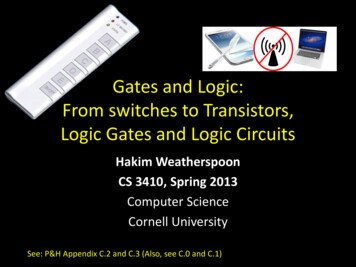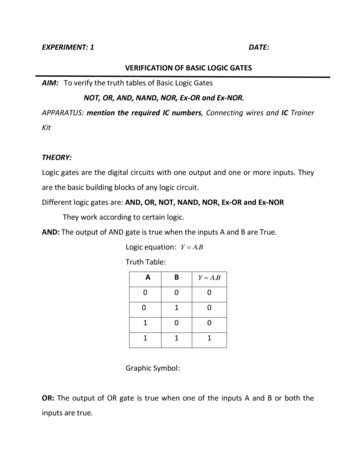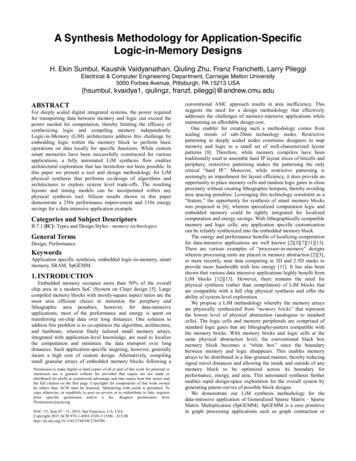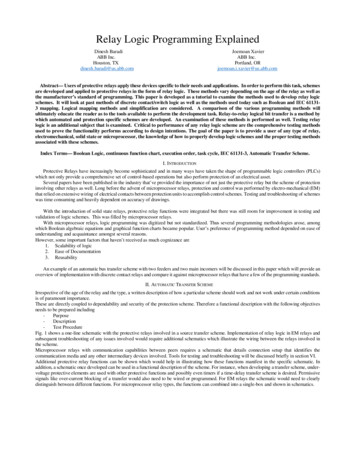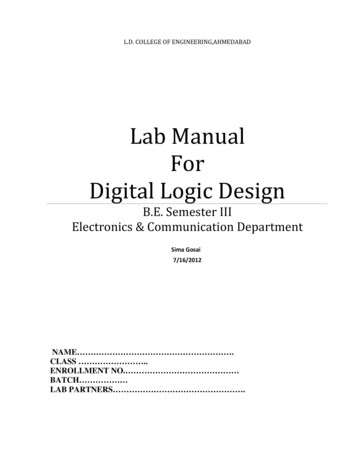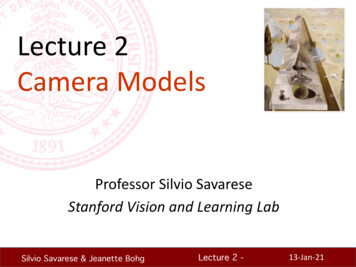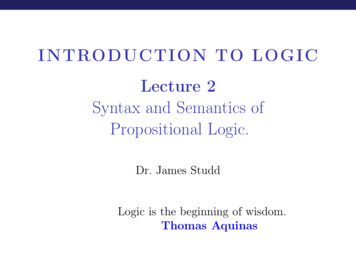
Transcription
I N T RO D U C T I O N T O L O G I CLecture 2Syntax and Semantics ofPropositional Logic.Dr. James StuddLogic is the beginning of wisdom.Thomas Aquinas
Outline1234Syntax vs Semantics.Syntax of L1 .Semantics of L1 .Truth-table methods.
Syntax vs. SemanticsSyntaxSyntax is all about expressions: words and sentences.
Syntax vs. SemanticsSyntaxSyntax is all about expressions: words and sentences.Examples of syntactic claims
Syntax vs. SemanticsSyntaxSyntax is all about expressions: words and sentences.Examples of syntactic claims‘Bertrand Russell’ is a proper noun.
Syntax vs. SemanticsSyntaxSyntax is all about expressions: words and sentences.Examples of syntactic claims‘Bertrand Russell’ is a proper noun.‘likes logic’ is a verb phrase.
Syntax vs. SemanticsSyntaxSyntax is all about expressions: words and sentences.Examples of syntactic claims‘Bertrand Russell’ is a proper noun.‘likes logic’ is a verb phrase.‘Bertrand Russell likes logic’ is a sentence.
Syntax vs. SemanticsSyntaxSyntax is all about expressions: words and sentences.Examples of syntactic claims‘Bertrand Russell’ is a proper noun.‘likes logic’ is a verb phrase.‘Bertrand Russell likes logic’ is a sentence.Combining a proper noun and a verb phrase in this waymakes a sentence.
Syntax vs. SemanticsSemanticsSemantics is all about meanings of expressions.
Syntax vs. SemanticsSemanticsSemantics is all about meanings of expressions.Examples of semantic claims
Syntax vs. SemanticsSemanticsSemantics is all about meanings of expressions.Examples of semantic claims‘Bertrand Russell’ refers to a British philosopher.
Syntax vs. SemanticsSemanticsSemantics is all about meanings of expressions.Examples of semantic claims‘Bertrand Russell’ refers to a British philosopher.‘Bertrand Russell’ refers to Bertrand Russell.
Syntax vs. SemanticsSemanticsSemantics is all about meanings of expressions.Examples of semantic claims‘Bertrand Russell’ refers to a British philosopher.‘Bertrand Russell’ refers to Bertrand Russell.‘likes logic’ expresses a property Russell has.
Syntax vs. SemanticsSemanticsSemantics is all about meanings of expressions.Examples of semantic claims‘Bertrand Russell’ refers to a British philosopher.‘Bertrand Russell’ refers to Bertrand Russell.‘likes logic’ expresses a property Russell has.‘Bertrand Russell likes logic’ is true.
Syntax vs. SemanticsUse vs MentionNote our use of quotes to talk about expressions.
Syntax vs. SemanticsUse vs MentionNote our use of quotes to talk about expressions.‘Bertrand Russell’ refers to Bertrand Russell.
Syntax vs. SemanticsUse vs MentionNote our use of quotes to talk about expressions.‘Bertrand Russell’ refers to Bertrand Russell.MentionThe first occurrence of ‘Bertrand Russell’ is an exampleof mention.
Syntax vs. SemanticsUse vs MentionNote our use of quotes to talk about expressions.‘Bertrand Russell’ refers to Bertrand Russell.MentionThe first occurrence of ‘Bertrand Russell’ is an exampleof mention.This occurrence (with quotes) refers to an expression.
Syntax vs. SemanticsUse vs MentionNote our use of quotes to talk about expressions.‘Bertrand Russell’ refers to Bertrand Russell.MentionThe first occurrence of ‘Bertrand Russell’ is an exampleof mention.This occurrence (with quotes) refers to an expression.UseThe second occurrence of ‘Bertrand Russell’ is anexample of use.
Syntax vs. SemanticsUse vs MentionNote our use of quotes to talk about expressions.‘Bertrand Russell’ refers to Bertrand Russell.MentionThe first occurrence of ‘Bertrand Russell’ is an exampleof mention.This occurrence (with quotes) refers to an expression.UseThe second occurrence of ‘Bertrand Russell’ is anexample of use.This occurrence (without quotes) refers to a man.
2.2 The Syntax of the Language of PropositionalSyntax: English vs. L1.English has many different sorts of expression.
2.2 The Syntax of the Language of PropositionalSyntax: English vs. L1.English has many different sorts of expression.Some expressions of English
2.2 The Syntax of the Language of PropositionalSyntax: English vs. L1.English has many different sorts of expression.Some expressions of English(1) Sentences: ‘Bertrand Russell likes logic’, ‘Philosophers likeconceptual analysis’, etc.
2.2 The Syntax of the Language of PropositionalSyntax: English vs. L1.English has many different sorts of expression.Some expressions of English(1) Sentences: ‘Bertrand Russell likes logic’, ‘Philosophers likeconceptual analysis’, etc.(2) Connectives: ‘it is not the case that’, ‘and’, etc.
2.2 The Syntax of the Language of PropositionalSyntax: English vs. L1.English has many different sorts of expression.Some expressions of English(1) Sentences: ‘Bertrand Russell likes logic’, ‘Philosophers likeconceptual analysis’, etc.(2) Connectives: ‘it is not the case that’, ‘and’, etc.(3) Noun phrases: ‘Bertrand Russell’, ‘Philosophers’, etc.
2.2 The Syntax of the Language of PropositionalSyntax: English vs. L1.English has many different sorts of expression.Some expressions of English(1) Sentences: ‘Bertrand Russell likes logic’, ‘Philosophers likeconceptual analysis’, etc.(2) Connectives: ‘it is not the case that’, ‘and’, etc.(3) Noun phrases: ‘Bertrand Russell’, ‘Philosophers’, etc.(4) Verb phrases: ‘likes logic’, ‘like conceptual analysis’, etc.
2.2 The Syntax of the Language of PropositionalSyntax: English vs. L1.English has many different sorts of expression.Some expressions of English(1) Sentences: ‘Bertrand Russell likes logic’, ‘Philosophers likeconceptual analysis’, etc.(2) Connectives: ‘it is not the case that’, ‘and’, etc.(3) Noun phrases: ‘Bertrand Russell’, ‘Philosophers’, etc.(4) Verb phrases: ‘likes logic’, ‘like conceptual analysis’, etc.(5) Also: nouns, verbs, pronouns, etc., etc., etc.
2.2 The Syntax of the Language of PropositionalSyntax: English vs. L1.English has many different sorts of expression.Some expressions of English(1) Sentences: ‘Bertrand Russell likes logic’, ‘Philosophers likeconceptual analysis’, etc.(2) Connectives: ‘it is not the case that’, ‘and’, etc.(3) Noun phrases: ‘Bertrand Russell’, ‘Philosophers’, etc.(4) Verb phrases: ‘likes logic’, ‘like conceptual analysis’, etc.(5) Also: nouns, verbs, pronouns, etc., etc., etc.L1 has just two sorts of basic expression.Some basic expressions of L1
2.2 The Syntax of the Language of PropositionalSyntax: English vs. L1.English has many different sorts of expression.Some expressions of English(1) Sentences: ‘Bertrand Russell likes logic’, ‘Philosophers likeconceptual analysis’, etc.(2) Connectives: ‘it is not the case that’, ‘and’, etc.(3) Noun phrases: ‘Bertrand Russell’, ‘Philosophers’, etc.(4) Verb phrases: ‘likes logic’, ‘like conceptual analysis’, etc.(5) Also: nouns, verbs, pronouns, etc., etc., etc.L1 has just two sorts of basic expression.Some basic expressions of L1(1) Sentence letters: e.g. ‘P’, ‘Q’.
2.2 The Syntax of the Language of PropositionalSyntax: English vs. L1.English has many different sorts of expression.Some expressions of English(1) Sentences: ‘Bertrand Russell likes logic’, ‘Philosophers likeconceptual analysis’, etc.(2) Connectives: ‘it is not the case that’, ‘and’, etc.(3) Noun phrases: ‘Bertrand Russell’, ‘Philosophers’, etc.(4) Verb phrases: ‘likes logic’, ‘like conceptual analysis’, etc.(5) Also: nouns, verbs, pronouns, etc., etc., etc.L1 has just two sorts of basic expression.Some basic expressions of L1(1) Sentence letters: e.g. ‘P’, ‘Q’.(2) Connectives: e.g. ‘ ’, ‘ ’.
2.2 The Syntax of the Language of PropositionalCombining sentences and connectives makes new sentences.
2.2 The Syntax of the Language of PropositionalCombining sentences and connectives makes new sentences.Some complex sentences
2.2 The Syntax of the Language of PropositionalCombining sentences and connectives makes new sentences.Some complex sentences‘It is not the case that’ and ‘Bertrand Russell likes logic’ make:‘It is not the case that Bertrand Russell likes logic’.
2.2 The Syntax of the Language of PropositionalCombining sentences and connectives makes new sentences.Some complex sentences‘It is not the case that’ and ‘Bertrand Russell likes logic’ make:‘It is not the case that Bertrand Russell likes logic’.‘ ’ and ‘P’ make: ‘ P ’.
2.2 The Syntax of the Language of PropositionalCombining sentences and connectives makes new sentences.Some complex sentences‘It is not the case that’ and ‘Bertrand Russell likes logic’ make:‘It is not the case that Bertrand Russell likes logic’.‘ ’ and ‘P’ make: ‘ P ’.‘Bertrand Russell likes logic’ and ‘and’ and ‘Philosophers likeconceptual analysis’ make:‘Bertrand Russell likes logic and philosophers like conceptualanalysis’.
2.2 The Syntax of the Language of PropositionalCombining sentences and connectives makes new sentences.Some complex sentences‘It is not the case that’ and ‘Bertrand Russell likes logic’ make:‘It is not the case that Bertrand Russell likes logic’.‘ ’ and ‘P’ make: ‘ P ’.‘Bertrand Russell likes logic’ and ‘and’ and ‘Philosophers likeconceptual analysis’ make:‘Bertrand Russell likes logic and philosophers like conceptualanalysis’.‘P ’, ‘ ’ and ‘Q’ make: ‘(P Q)’.
2.2 The Syntax of the Language of PropositionalCombining sentences and connectives makes new sentences.Some complex sentences‘It is not the case that’ and ‘Bertrand Russell likes logic’ make:‘It is not the case that Bertrand Russell likes logic’.‘ ’ and ‘P’ make: ‘ P ’.‘Bertrand Russell likes logic’ and ‘and’ and ‘Philosophers likeconceptual analysis’ make:‘Bertrand Russell likes logic and philosophers like conceptualanalysis’.‘P ’, ‘ ’ and ‘Q’ make: ‘(P Q)’.Logic convention: no quotes around L1 -expressions.
2.2 The Syntax of the Language of PropositionalCombining sentences and connectives makes new sentences.Some complex sentences‘It is not the case that’ and ‘Bertrand Russell likes logic’ make:‘It is not the case that Bertrand Russell likes logic’.‘ ’ and ‘P’ make: ‘ P ’.‘Bertrand Russell likes logic’ and ‘and’ and ‘Philosophers likeconceptual analysis’ make:‘Bertrand Russell likes logic and philosophers like conceptualanalysis’.‘P ’, ‘ ’ and ‘Q’ make: ‘(P Q)’.Logic convention: no quotes around L1 -expressions.P , and Q make: (P Q).
2.2 The Syntax of the Language of PropositionalConnectivesHere’s the full list of L1 owdouble arrowin Englishandorit is not thecase thatif . . . thenif and only ifsymbol
2.2 The Syntax of the Language of PropositionalConnectivesHere’s the full list of L1 owdouble arrowin Englishandorit is not thecase thatif . . . thenif and only ifsymbol
2.2 The Syntax of the Language of PropositionalConnectivesHere’s the full list of L1 owdouble arrowin Englishandorit is not thecase thatif . . . thenif and only ifsymbol
2.2 The Syntax of the Language of PropositionalConnectivesHere’s the full list of L1 owdouble arrowin Englishandorit is not thecase thatif . . . thenif and only ifsymbol
2.2 The Syntax of the Language of PropositionalConnectivesHere’s the full list of L1 owdouble arrowin Englishandorit is not thecase thatif . . . thenif and only ifsymbol
2.2 The Syntax of the Language of PropositionalConnectivesHere’s the full list of L1 owdouble arrowin Englishandorit is not thecase thatif . . . thenif and only ifsymbol
2.2 The Syntax of the Language of PropositionalThe syntax of L1Here’s the official definition of L1 -sentence.
2.2 The Syntax of the Language of PropositionalThe syntax of L1Here’s the official definition of L1 -sentence.Definition
2.2 The Syntax of the Language of PropositionalThe syntax of L1Here’s the official definition of L1 -sentence.Definition(i) All sentence letters are sentences of L1 :
2.2 The Syntax of the Language of PropositionalThe syntax of L1Here’s the official definition of L1 -sentence.Definition(i) All sentence letters are sentences of L1 :P, Q, R, P1 , Q1 , R1 , P2 , Q2 , R2 , P3 , . . .
2.2 The Syntax of the Language of PropositionalThe syntax of L1Here’s the official definition of L1 -sentence.Definition(i) All sentence letters are sentences of L1 :P, Q, R, P1 , Q1 , R1 , P2 , Q2 , R2 , P3 , . . .(ii) If φ and ψ are sentences of L1 , then so are:
2.2 The Syntax of the Language of PropositionalThe syntax of L1Here’s the official definition of L1 -sentence.Definition(i) All sentence letters are sentences of L1 :P, Q, R, P1 , Q1 , R1 , P2 , Q2 , R2 , P3 , . . .(ii) If φ and ψ are sentences of L1 , then so are: φ
2.2 The Syntax of the Language of PropositionalThe syntax of L1Here’s the official definition of L1 -sentence.Definition(i) All sentence letters are sentences of L1 :P, Q, R, P1 , Q1 , R1 , P2 , Q2 , R2 , P3 , . . .(ii) If φ and ψ are sentences of L1 , then so are: φ(φ ψ)
2.2 The Syntax of the Language of PropositionalThe syntax of L1Here’s the official definition of L1 -sentence.Definition(i) All sentence letters are sentences of L1 :P, Q, R, P1 , Q1 , R1 , P2 , Q2 , R2 , P3 , . . .(ii) If φ and ψ are sentences of L1 , then so are: φ(φ ψ)(φ ψ)
2.2 The Syntax of the Language of PropositionalThe syntax of L1Here’s the official definition of L1 -sentence.Definition(i) All sentence letters are sentences of L1 :P, Q, R, P1 , Q1 , R1 , P2 , Q2 , R2 , P3 , . . .(ii) If φ and ψ are sentences of L1 , then so are: φ(φ ψ)(φ ψ)(φ ψ)
2.2 The Syntax of the Language of PropositionalThe syntax of L1Here’s the official definition of L1 -sentence.Definition(i) All sentence letters are sentences of L1 :P, Q, R, P1 , Q1 , R1 , P2 , Q2 , R2 , P3 , . . .(ii) If φ and ψ are sentences of L1 , then so are: φ(φ ψ)(φ ψ)(φ ψ)(φ ψ)
2.2 The Syntax of the Language of PropositionalThe syntax of L1Here’s the official definition of L1 -sentence.Definition(i) All sentence letters are sentences of L1 :P, Q, R, P1 , Q1 , R1 , P2 , Q2 , R2 , P3 , . . .(ii) If φ and ψ are sentences of L1 , then so are: φ(φ ψ)(φ ψ)(φ ψ)(φ ψ)(iii) Nothing else is a sentence of L1 .
2.2 The Syntax of the Language of PropositionalThe syntax of L1Here’s the official definition of L1 -sentence.Definition(i) All sentence letters are sentences of L1 :P, Q, R, P1 , Q1 , R1 , P2 , Q2 , R2 , P3 , . . .(ii) If φ and ψ are sentences of L1 , then so are: φ(φ ψ)(φ ψ)(φ ψ)(φ ψ)(iii) Nothing else is a sentence of L1 .Greek letters: φ (‘PHI’) and ψ (‘PSI’): not part of L1 .
2.2 The Syntax of the Language of PropositionalHow to build a sentence of L1ExampleThe following is a sentence of L1 :Definition of L1 -sentences (repeated from previous page)(i) All sentence letters are sentences of L1 .(ii) If φ and ψ are sentences of L1 , then φ, (φ ψ),(φ ψ), (φ ψ) and (φ ψ) are sentences of L1 .(iii) Nothing else is a sentence of L1 .
2.2 The Syntax of the Language of PropositionalHow to build a sentence of L1ExampleThe following is a sentence of L1 :PDefinition of L1 -sentences (repeated from previous page)(i) All sentence letters are sentences of L1 .(ii) If φ and ψ are sentences of L1 , then φ, (φ ψ),(φ ψ), (φ ψ) and (φ ψ) are sentences of L1 .(iii) Nothing else is a sentence of L1 .
2.2 The Syntax of the Language of PropositionalHow to build a sentence of L1ExampleThe following is a sentence of L1 :PQDefinition of L1 -sentences (repeated from previous page)(i) All sentence letters are sentences of L1 .(ii) If φ and ψ are sentences of L1 , then φ, (φ ψ),(φ ψ), (φ ψ) and (φ ψ) are sentences of L1 .(iii) Nothing else is a sentence of L1 .
2.2 The Syntax of the Language of PropositionalHow to build a sentence of L1ExampleThe following is a sentence of L1 :(P Q)Definition of L1 -sentences (repeated from previous page)(i) All sentence letters are sentences of L1 .(ii) If φ and ψ are sentences of L1 , then φ, (φ ψ),(φ ψ), (φ ψ) and (φ ψ) are sentences of L1 .(iii) Nothing else is a sentence of L1 .
2.2 The Syntax of the Language of PropositionalHow to build a sentence of L1ExampleThe following is a sentence of L1 :(P Q)R45Definition of L1 -sentences (repeated from previous page)(i) All sentence letters are sentences of L1 .(ii) If φ and ψ are sentences of L1 , then φ, (φ ψ),(φ ψ), (φ ψ) and (φ ψ) are sentences of L1 .(iii) Nothing else is a sentence of L1 .
2.2 The Syntax of the Language of PropositionalHow to build a sentence of L1ExampleThe following is a sentence of L1 :(P Q) R45Definition of L1 -sentences (repeated from previous page)(i) All sentence letters are sentences of L1 .(ii) If φ and ψ are sentences of L1 , then φ, (φ ψ),(φ ψ), (φ ψ) and (φ ψ) are sentences of L1 .(iii) Nothing else is a sentence of L1 .
2.2 The Syntax of the Language of PropositionalHow to build a sentence of L1ExampleThe following is a sentence of L1 :(P Q)P R45Definition of L1 -sentences (repeated from previous page)(i) All sentence letters are sentences of L1 .(ii) If φ and ψ are sentences of L1 , then φ, (φ ψ),(φ ψ), (φ ψ) and (φ ψ) are sentences of L1 .(iii) Nothing else is a sentence of L1 .
2.2 The Syntax of the Language of PropositionalHow to build a sentence of L1ExampleThe following is a sentence of L1 :(P Q)(P R45 )Definition of L1 -sentences (repeated from previous page)(i) All sentence letters are sentences of L1 .(ii) If φ and ψ are sentences of L1 , then φ, (φ ψ),(φ ψ), (φ ψ) and (φ ψ) are sentences of L1 .(iii) Nothing else is a sentence of L1 .
2.2 The Syntax of the Language of PropositionalHow to build a sentence of L1ExampleThe following is a sentence of L1 :((P Q) (P R45 ))Definition of L1 -sentences (repeated from previous page)(i) All sentence letters are sentences of L1 .(ii) If φ and ψ are sentences of L1 , then φ, (φ ψ),(φ ψ), (φ ψ) and (φ ψ) are sentences of L1 .(iii) Nothing else is a sentence of L1 .
2.2 The Syntax of the Language of PropositionalHow to build a sentence of L1ExampleThe following is a sentence of L1 :((P Q) (P R45 ))P3Definition of L1 -sentences (repeated from previous page)(i) All sentence letters are sentences of L1 .(ii) If φ and ψ are sentences of L1 , then φ, (φ ψ),(φ ψ), (φ ψ) and (φ ψ) are sentences of L1 .(iii) Nothing else is a sentence of L1 .
2.2 The Syntax of the Language of PropositionalHow to build a sentence of L1ExampleThe following is a sentence of L1 :((P Q) (P R45 ))P3RDefinition of L1 -sentences (repeated from previous page)(i) All sentence letters are sentences of L1 .(ii) If φ and ψ are sentences of L1 , then φ, (φ ψ),(φ ψ), (φ ψ) and (φ ψ) are sentences of L1 .(iii) Nothing else is a sentence of L1 .
2.2 The Syntax of the Language of PropositionalHow to build a sentence of L1ExampleThe following is a sentence of L1 :((P Q) (P R45 ))(P3 R)Definition of L1 -sentences (repeated from previous page)(i) All sentence letters are sentences of L1 .(ii) If φ and ψ are sentences of L1 , then φ, (φ ψ),(φ ψ), (φ ψ) and (φ ψ) are sentences of L1 .(iii) Nothing else is a sentence of L1 .
2.2 The Syntax of the Language of PropositionalHow to build a sentence of L1ExampleThe following is a sentence of L1 :((P Q) (P R45 ))(P3 R)RDefinition of L1 -sentences (repeated from previous page)(i) All sentence letters are sentences of L1 .(ii) If φ and ψ are sentences of L1 , then φ, (φ ψ),(φ ψ), (φ ψ) and (φ ψ) are sentences of L1 .(iii) Nothing else is a sentence of L1 .
2.2 The Syntax of the Language of PropositionalHow to build a sentence of L1ExampleThe following is a sentence of L1 :((P Q) (P R45 ))((P3 R) R)Definition of L1 -sentences (repeated from previous page)(i) All sentence letters are sentences of L1 .(ii) If φ and ψ are sentences of L1 , then φ, (φ ψ),(φ ψ), (φ ψ) and (φ ψ) are sentences of L1 .(iii) Nothing else is a sentence of L1 .
2.2 The Syntax of the Language of PropositionalHow to build a sentence of L1ExampleThe following is a sentence of L1 :((P Q) (P R45 )) ((P3 R) R)Definition of L1 -sentences (repeated from previous page)(i) All sentence letters are sentences of L1 .(ii) If φ and ψ are sentences of L1 , then φ, (φ ψ),(φ ψ), (φ ψ) and (φ ψ) are sentences of L1 .(iii) Nothing else is a sentence of L1 .
2.2 The Syntax of the Language of PropositionalHow to build a sentence of L1ExampleThe following is a sentence of L1 :(((P Q) (P R45 )) ((P3 R) R))Definition of L1 -sentences (repeated from previous page)(i) All sentence letters are sentences of L1 .(ii) If φ and ψ are sentences of L1 , then φ, (φ ψ),(φ ψ), (φ ψ) and (φ ψ) are sentences of L1 .(iii) Nothing else is a sentence of L1 .
2.2 The Syntax of the Language of PropositionalHow to build a sentence of L1ExampleThe following is a sentence of L1 : (((P Q) (P R45 )) ((P3 R) R))Definition of L1 -sentences (repeated from previous page)(i) All sentence letters are sentences of L1 .(ii) If φ and ψ are sentences of L1 , then φ, (φ ψ),(φ ψ), (φ ψ) and (φ ψ) are sentences of L1 .(iii) Nothing else is a sentence of L1 .
2.2 The Syntax of the Language of PropositionalHow to build a sentence of L1ExampleThe following is a sentence of L1 : (((P Q) (P R45 )) ((P3 R) R))Definition of L1 -sentences (repeated from previous page)(i) All sentence letters are sentences of L1 .(ii) If φ and ψ are sentences of L1 , then φ, (φ ψ),(φ ψ), (φ ψ) and (φ ψ) are sentences of L1 .(iii) Nothing else is a sentence of L1 .
2.2 The Syntax of the Language of PropositionalObject vs. MetalanguageI mentioned that φ and ψ are not part of L1 .
2.2 The Syntax of the Language of PropositionalObject vs. MetalanguageI mentioned that φ and ψ are not part of L1 . P is a L1 -sentence.
2.2 The Syntax of the Language of PropositionalObject vs. MetalanguageI mentioned that φ and ψ are not part of L1 . P is a L1 -sentence. φ describes many L1 -sentences
2.2 The Syntax of the Language of PropositionalObject vs. MetalanguageI mentioned that φ and ψ are not part of L1 . P is a L1 -sentence. φ describes many L1 -sentencese.g. P , (Q R), (P (Q R)), . . .
2.2 The Syntax of the Language of PropositionalObject vs. MetalanguageI mentioned that φ and ψ are not part of L1 . P is a L1 -sentence. φ describes many L1 -sentences (but is not one itself).e.g. P , (Q R), (P (Q R)), . . .
2.2 The Syntax of the Language of PropositionalObject vs. MetalanguageI mentioned that φ and ψ are not part of L1 . P is a L1 -sentence. φ describes many L1 -sentences (but is not one itself).e.g. P , (Q R), (P (Q R)), . . .φ and ψ are part of the metalanguage, not the object one.
2.2 The Syntax of the Language of PropositionalObject vs. MetalanguageI mentioned that φ and ψ are not part of L1 . P is a L1 -sentence. φ describes many L1 -sentences (but is not one itself).e.g. P , (Q R), (P (Q R)), . . .φ and ψ are part of the metalanguage, not the object one.Object languageThe object language is the one we’re theorising about.
2.2 The Syntax of the Language of PropositionalObject vs. MetalanguageI mentioned that φ and ψ are not part of L1 . P is a L1 -sentence. φ describes many L1 -sentences (but is not one itself).e.g. P , (Q R), (P (Q R)), . . .φ and ψ are part of the metalanguage, not the object one.Object languageThe object language is the one we’re theorising about.The object language is L1 .
2.2 The Syntax of the Language of PropositionalObject vs. MetalanguageI mentioned that φ and ψ are not part of L1 . P is a L1 -sentence. φ describes many L1 -sentences (but is not one itself).e.g. P , (Q R), (P (Q R)), . . .φ and ψ are part of the metalanguage, not the object one.Object languageThe object language is the one we’re theorising about.The object language is L1 .MetalanguageThe metalanguage is the one we’re theorising in.
2.2 The Syntax of the Language of PropositionalObject vs. MetalanguageI mentioned that φ and ψ are not part of L1 . P is a L1 -sentence. φ describes many L1 -sentences (but is not one itself).e.g. P , (Q R), (P (Q R)), . . .φ and ψ are part of the metalanguage, not the object one.Object languageThe object language is the one we’re theorising about.The object language is L1 .MetalanguageThe metalanguage is the one we’re theorising in.The metalanguage is (augmented) English.
2.2 The Syntax of the Language of PropositionalObject vs. MetalanguageI mentioned that φ and ψ are not part of L1 . P is a L1 -sentence. φ describes many L1 -sentences (but is not one itself).e.g. P , (Q R), (P (Q R)), . . .φ and ψ are part of the metalanguage, not the object one.Object languageThe object language is the one we’re theorising about.The object language is L1 .MetalanguageThe metalanguage is the one we’re theorising in.The metalanguage is (augmented) English.φ and ψ are used as variables in the metalanguage:in order to generalise about sentences of the object language.
2.3 Rules for Dropping BracketsBracketing conventionsThere are conventions for dropping brackets in L1 .
2.3 Rules for Dropping BracketsBracketing conventionsThere are conventions for dropping brackets in L1 .Some are similar to rules used for and in arithmetic.
2.3 Rules for Dropping BracketsBracketing conventionsThere are conventions for dropping brackets in L1 .Some are similar to rules used for and in arithmetic.Example in arithmetic
2.3 Rules for Dropping BracketsBracketing conventionsThere are conventions for dropping brackets in L1 .Some are similar to rules used for and in arithmetic.Example in arithmetic4 5 3
2.3 Rules for Dropping BracketsBracketing conventionsThere are conventions for dropping brackets in L1 .Some are similar to rules used for and in arithmetic.Example in arithmetic4 5 3 does not abbreviate (4 5) 3.
2.3 Rules for Dropping BracketsBracketing conventionsThere are conventions for dropping brackets in L1 .Some are similar to rules used for and in arithmetic.Example in arithmetic4 5 3 does not abbreviate (4 5) 3. ‘binds more strongly’ than .
2.3 Rules for Dropping BracketsBracketing conventionsThere are conventions for dropping brackets in L1 .Some are similar to rules used for and in arithmetic.Example in arithmetic4 5 3 does not abbreviate (4 5) 3. ‘binds more strongly’ than .4 5 3 abbreviates 4 (5 3).
2.3 Rules for Dropping BracketsBracketing conventionsThere are conventions for dropping brackets in L1 .Some are similar to rules used for and in arithmetic.Example in arithmetic4 5 3 does not abbreviate (4 5) 3. ‘binds more strongly’ than .4 5 3 abbreviates 4 (5 3).Examples in L1
2.3 Rules for Dropping BracketsBracketing conventionsThere are conventions for dropping brackets in L1 .Some are similar to rules used for and in arithmetic.Example in arithmetic4 5 3 does not abbreviate (4 5) 3. ‘binds more strongly’ than .4 5 3 abbreviates 4 (5 3).Examples in L1 and bind more strongly than and .
2.3 Rules for Dropping BracketsBracketing conventionsThere are conventions for dropping brackets in L1 .Some are similar to rules used for and in arithmetic.Example in arithmetic4 5 3 does not abbreviate (4 5) 3. ‘binds more strongly’ than .4 5 3 abbreviates 4 (5 3).Examples in L1 and bind more strongly than and .(P Q R) abbreviates (P (Q R)).
2.3 Rules for Dropping BracketsBracketing conventionsThere are conventions for dropping brackets in L1 .Some are similar to rules used for and in arithmetic.Example in arithmetic4 5 3 does not abbreviate (4 5) 3. ‘binds more strongly’ than .4 5 3 abbreviates 4 (5 3).Examples in L1 and bind more strongly than and .(P Q R) abbreviates (P (Q R)).One may drop outer brackets.
2.3 Rules for Dropping BracketsBracketing conventionsThere are conventions for dropping brackets in L1 .Some are similar to rules used for and in arithmetic.Example in arithmetic4 5 3 does not abbreviate (4 5) 3. ‘binds more strongly’ than .4 5 3 abbreviates 4 (5 3).Examples in L1 and bind more strongly than and .(P Q R) abbreviates (P (Q R)).One may drop outer brackets.P (Q P4 ) abbreviates (P (Q P4 )).
2.3 Rules for Dropping BracketsBracketing conventionsThere are conventions for dropping brackets in L1 .Some are similar to rules used for and in arithmetic.Example in arithmetic4 5 3 does not abbreviate (4 5) 3. ‘binds more strongly’ than .4 5 3 abbreviates 4 (5 3).Examples in L1 and bind more strongly than and .(P Q R) abbreviates (P (Q R)).One may drop outer brackets.P (Q P4 ) abbreviates (P (Q P4 )).One may drop brackets on strings of s or s.
2.3 Rules for Dropping BracketsBracketing conventionsThere are conventions for dropping brackets in L1 .Some are similar to rules used for and in arithmetic.Example in arithmetic4 5 3 does not abbreviate (4 5) 3. ‘binds more strongly’ than .4 5 3 abbreviates 4 (5 3).Examples in L1 and bind more strongly than and .(P Q R) abbreviates (P (Q R)).One may drop outer brackets.P (Q P4 ) abbreviates (P (Q P4 )).One may drop brackets on strings of s or s.(P Q R) abbreviates ((P Q) R).25
2.3 Rules for Dropping BracketsBracketing conventionsThere are conventions for dropping brackets in L1 .Some are similar to rules used for and in arithmetic.Example in arithmetic4 5 3 d
Syntax and Semantics of Propositional Logic. Dr.JamesStudd Logicisthebeginningofwisdom. ThomasAquinas. Outline 1 SyntaxvsSemantics. 2 SyntaxofL 1. 3 SemanticsofL 1. 4 Truth-tablemethods. Syntax vs. Semantics Syntax Syntaxisallabout


